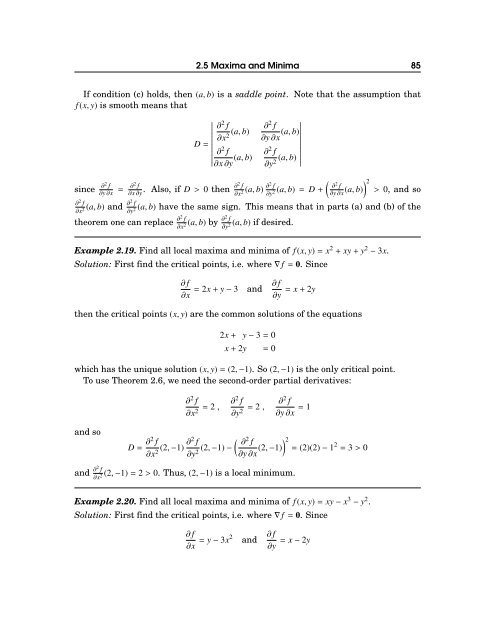Michael Corral: Vector Calculus
Michael Corral: Vector Calculus
Michael Corral: Vector Calculus
Create successful ePaper yourself
Turn your PDF publications into a flip-book with our unique Google optimized e-Paper software.
2.5 Maxima and Minima 85<br />
If condition (c) holds, then (a,b) is a saddle point. Note that the assumption that<br />
f(x,y) is smooth means that<br />
∂ 2 f ∂ 2 ∣<br />
f ∣∣∣∣∣∣∣∣∣∣∣<br />
D=<br />
∂x 2(a,b) ∂y∂x (a,b)<br />
∂ 2 f<br />
∣∂x∂y (a,b) ∂ 2 f<br />
∂y 2(a,b)<br />
( )<br />
since ∂2 f<br />
∂y∂x = ∂2 f<br />
∂x∂y . Also, if D>0 then ∂2 f<br />
(a,b) ∂2 f<br />
(a,b)=D+ ∂ 2 f 2>0,<br />
∂x 2 ∂y 2 ∂y∂x (a,b) and so<br />
∂ 2 f<br />
(a,b) and ∂2 f<br />
(a,b) have the same sign. This means that in parts (a) and (b) of the<br />
∂x 2 ∂y 2<br />
theorem one can replace ∂2 f<br />
(a,b) by ∂2 f<br />
(a,b) if desired.<br />
∂x 2 ∂y 2<br />
Example 2.19. Find all local maxima and minima of f(x,y)= x 2 + xy+y 2 −3x.<br />
Solution: First find the critical points, i.e. where∇f= 0. Since<br />
∂f<br />
∂x<br />
= 2x+y−3 and<br />
∂f<br />
∂y = x+2y<br />
then the critical points (x,y) are the common solutions of the equations<br />
2x+ y−3=0<br />
x+2y = 0<br />
which has the unique solution (x,y)=(2,−1). So (2,−1) is the only critical point.<br />
To use Theorem 2.6, we need the second-order partial derivatives:<br />
∂ 2 f<br />
∂x 2= 2, ∂ 2 f<br />
∂y 2= 2, ∂ 2 f<br />
∂y∂x = 1<br />
and so<br />
D= ∂2 f<br />
∂x 2(2,−1)∂2 f<br />
∂y 2(2,−1)− ( ∂ 2 f<br />
∂y∂x (2,−1) ) 2=<br />
(2)(2)−1 2 = 3>0<br />
and ∂2 f<br />
∂x 2 (2,−1)=2>0. Thus, (2,−1) is a local minimum.<br />
Example 2.20. Find all local maxima and minima of f(x,y)= xy− x 3 −y 2 .<br />
Solution: First find the critical points, i.e. where∇f= 0. Since<br />
∂f<br />
∂x = y−3x2 and ∂f<br />
∂y = x−2y








